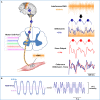Low-Frequency Oscillations and Control of the Motor Output
- PMID: 28261107
- PMCID: PMC5306248
- DOI: 10.3389/fphys.2017.00078
Low-Frequency Oscillations and Control of the Motor Output
Abstract
A less precise force output impairs our ability to perform movements, learn new motor tasks, and use tools. Here we show that low-frequency oscillations in force are detrimental to force precision. We summarize the recent evidence that low-frequency oscillations in force output represent oscillations of the spinal motor neuron pool from the voluntary drive, and can be modulated by shifting power to higher frequencies. Further, force oscillations below 0.5 Hz impair force precision with increased voluntary drive, aging, and neurological disease. We argue that the low-frequency oscillations are (1) embedded in the descending drive as shown by the activation of multiple spinal motor neurons, (2) are altered with force intensity and brain pathology, and (3) can be modulated by visual feedback and motor training to enhance force precision. Thus, low-frequency oscillations in force provide insight into how the human brain regulates force precision.
Keywords: corticomuscular coherence; force precision; force variability; motor control; voluntary drive.
Figures




Similar articles
-
Voluntary reduction of force variability via modulation of low-frequency oscillations.Exp Brain Res. 2017 Sep;235(9):2717-2727. doi: 10.1007/s00221-017-5005-5. Epub 2017 Jun 12. Exp Brain Res. 2017. PMID: 28608243
-
Motor output oscillations with magnification of visual feedback in older adults.Neurosci Lett. 2017 Apr 24;647:8-13. doi: 10.1016/j.neulet.2017.03.011. Epub 2017 Mar 12. Neurosci Lett. 2017. PMID: 28300635
-
Decrease in force steadiness with aging is associated with increased power of the common but not independent input to motor neurons.J Neurophysiol. 2018 Oct 1;120(4):1616-1624. doi: 10.1152/jn.00093.2018. Epub 2018 Jul 5. J Neurophysiol. 2018. PMID: 29975167 Free PMC article.
-
Human spinal cord injury: motor unit properties and behaviour.Acta Physiol (Oxf). 2014 Jan;210(1):5-19. doi: 10.1111/apha.12153. Epub 2013 Sep 13. Acta Physiol (Oxf). 2014. PMID: 23901835 Review.
-
Evidence for a supraspinal contribution to human muscle fatigue.Clin Exp Pharmacol Physiol. 2006 Apr;33(4):400-5. doi: 10.1111/j.1440-1681.2006.04363.x. Clin Exp Pharmacol Physiol. 2006. PMID: 16620309 Review.
Cited by
-
Oscillations in neural drive and age-related reductions in force steadiness with a cognitive challenge.J Appl Physiol (1985). 2019 Apr 1;126(4):1056-1065. doi: 10.1152/japplphysiol.00821.2018. Epub 2019 Feb 28. J Appl Physiol (1985). 2019. PMID: 30817244 Free PMC article.
-
Adolescent boys who participate in sports exhibit similar ramp torque control with young men despite differences in strength and tendon characteristics.Eur J Appl Physiol. 2023 May;123(5):965-974. doi: 10.1007/s00421-022-05130-y. Epub 2023 Jan 6. Eur J Appl Physiol. 2023. PMID: 36607415 Free PMC article.
-
The modulation of force steadiness by electrical nerve stimulation applied to the wrist extensors differs for young and older adults.Eur J Appl Physiol. 2019 Jan;119(1):301-310. doi: 10.1007/s00421-018-4025-6. Epub 2018 Oct 30. Eur J Appl Physiol. 2019. PMID: 30377779
-
Sinusoidal vibrotactile stimulation differentially improves force steadiness depending on contraction intensity.Med Biol Eng Comput. 2019 Aug;57(8):1813-1822. doi: 10.1007/s11517-019-01999-8. Epub 2019 Jun 14. Med Biol Eng Comput. 2019. PMID: 31197752
-
Resting-state cortical electroencephalogram rhythms and network in patients after chronic stroke.J Neuroeng Rehabil. 2024 Feb 29;21(1):32. doi: 10.1186/s12984-024-01328-7. J Neuroeng Rehabil. 2024. PMID: 38424592 Free PMC article.
References
-
- Bernstein N. (1967). The Coordination and Regulation of Movements. Oxford: Pergamon Press.
Publication types
LinkOut - more resources
Full Text Sources
Other Literature Sources

